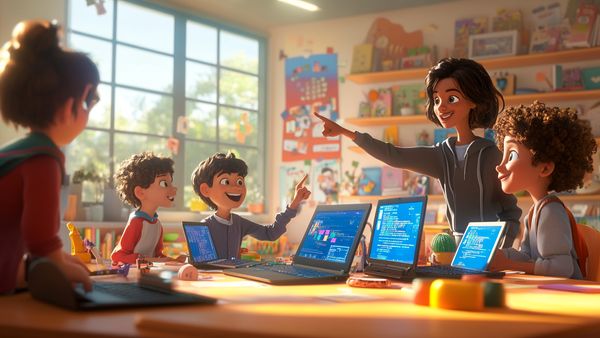In today’s fast-evolving digital world, learning to code is an invaluable skill for children. Coding not only builds logical thinking and creativity but also prepares kids for future careers in technology. As parents and educators, introducing coding in a fun and accessible way can transform children into innovative thinkers and problem solvers. Let’s explore exciting, hands-on methods to get your kids hooked on coding while ensuring they develop a strong foundation in computational thinking.

Why Teach Kids Coding?
Coding has become an essential part of modern education. Here are some reasons why you should introduce coding to your child:
- Builds Problem-Solving Skills: Coding encourages logical thinking and teaches kids to tackle problems systematically.
- Enhances Creativity: From creating games to designing animations, coding fosters a child’s imagination.
- Prepares for the Future: Coding skills are increasingly in demand across industries, offering a head start in many career paths.
- Encourages Collaboration: Working on coding projects helps children develop teamwork and communication skills.
Fun Ways to Get Kids Into Coding
1. Start with Visual Programming Languages
One of the simplest ways to introduce kids to coding is through visual programming tools like Scratch. This kid-friendly platform uses a drag-and-drop interface, allowing children to create:
- Interactive Animations
- Engaging Games
- Simple Storyboards
Scratch’s colorful blocks simplify complex coding concepts. Additionally, its online community provides access to inspiring projects and fosters collaboration among young coders.
Benefits of Visual Programming:
- Easy to learn and understand.
- Focuses on logic and creativity rather than syntax.
- Provides instant feedback, keeping kids motivated.
2. Incorporate Coding into Daily Activities
Coding doesn’t always require a computer. Everyday activities can teach coding principles:
- Cooking: Use recipes to explain sequencing.
- Treasure Hunts: Introduce loops and conditionals by creating step-by-step instructions.
- Board Games: Play strategy-based games like Chess to build algorithmic thinking.
Example Activity: Code Your Morning Routine
Ask your child to write out a step-by-step plan for their morning activities. This introduces them to algorithms and debugging when they identify unnecessary or missing steps.
3. Explore Educational Robotics Kits
Robotics kits like LEGO Mindstorms and Arduino Starter Kits are perfect for hands-on learners. These kits enable kids to build robots and program them using basic commands.
Key Benefits:
- Encourages experimentation and innovation.
- Develops mechanical and software skills simultaneously.
- Provides real-time feedback, ensuring an engaging learning experience.
With robotics, kids can create:
- Line-following robots.
- Obstacle-avoiding machines.
- Programmable robotic arms.
4. Leverage Online Coding Platforms
Platforms like Code.org, Tynker, and Khan Academy offer interactive lessons that grow in complexity as kids progress. These platforms include:
- Gamified challenges to keep learning fun.
- Comprehensive tutorials for beginners.
- Tools to create projects ranging from websites to games.
Advantages of Online Learning:
- Flexibility to learn at your own pace.
- Access to a global community of young coders.
- Opportunity to participate in coding contests and events.
5. Encourage Real-World Projects
Kids learn best when they see the real-world impact of their work. Encourage them to:
- Design Personal Websites: Use beginner-friendly tools like WordPress or Wix.
- Develop Simple Apps: Platforms like MIT App Inventor allow kids to create basic mobile applications.
- Build Games: Tools like Roblox Studio let children design their own virtual worlds.
Real-world projects provide a sense of achievement and can serve as a portfolio to showcase their skills in the future.
6. Join Local Coding Clubs and Competitions
Engaging with peers through local coding clubs or online forums fosters collaborative learning. Kids can:
- Share ideas and learn from others.
- Participate in hackathons to tackle real-world challenges.
- Gain exposure to diverse coding techniques.
Community events also build confidence and provide mentorship opportunities.




